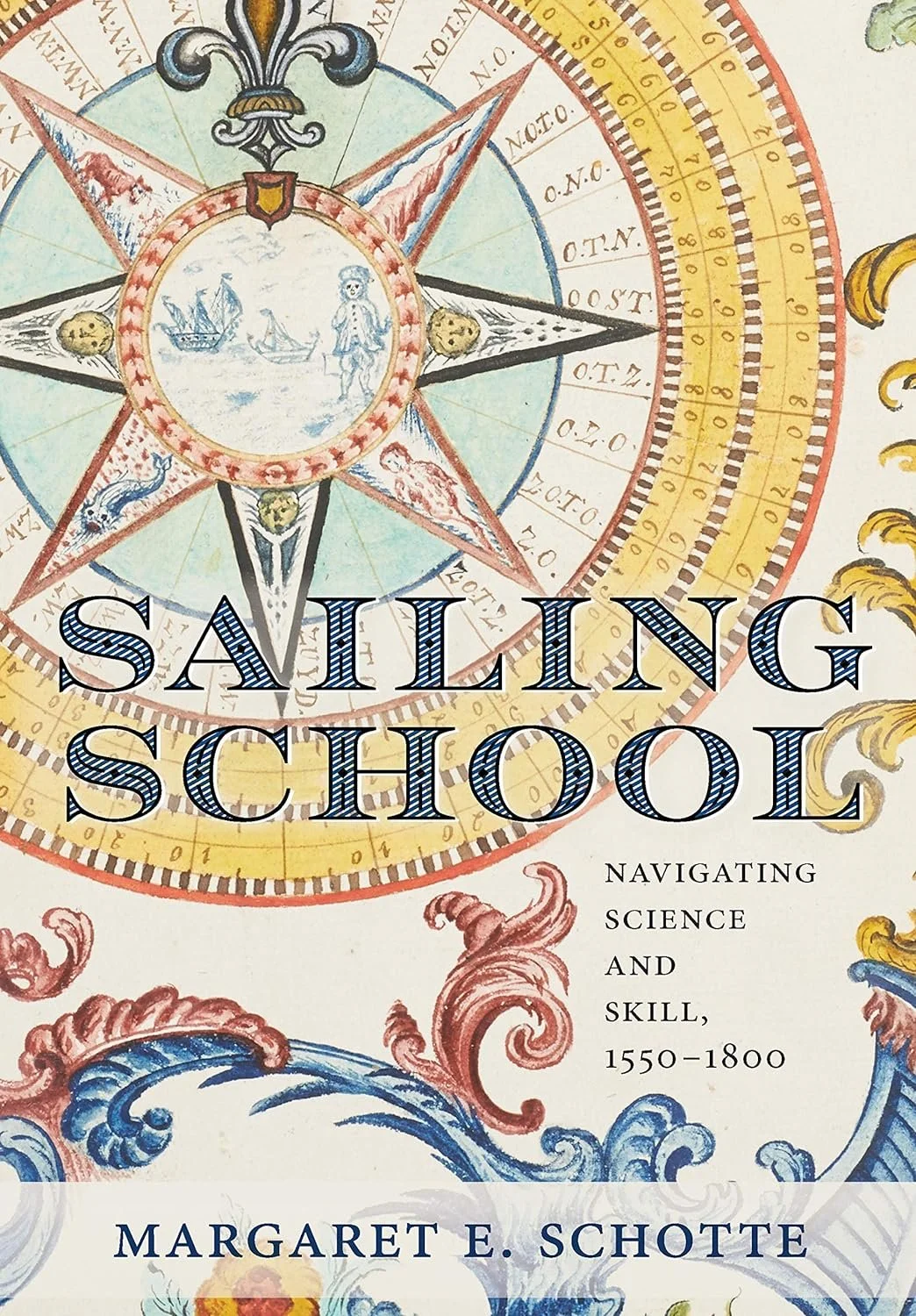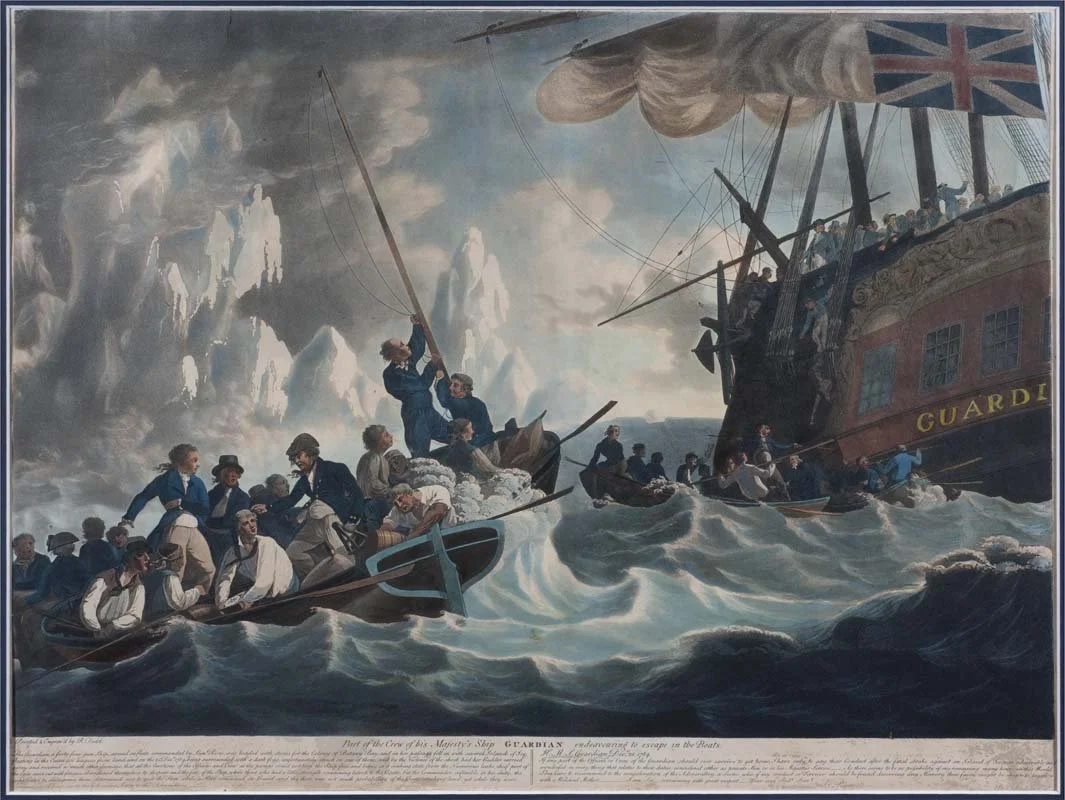In Neptune's Vast Dominions
Winter in this part of the world, still has a long way to run. You could do a lot worse than get your hands on a copy of this book, turn off Netflix, and settled down in a sprawling armchair, immersing yourself in the history of this vanishing science.
A book review of Margaret E Schotte’s “Sailing School : Navigating Science and Skill 1550-1800”
By Mathew Lyons in the Literary Review
On Christmas Eve 1789, HMS Guardian found itself in the shadow of two great icebergs some 1,300 miles southeast of the Cape of Good Hope. The ship’s captain, 27-year-old Edward Riou, ordered a double watch to be kept, but, engulfed in fog and with darkness falling, the Guardian struck one all the same. The collision tore a hole in the ship’s hull beneath the waterline and destroyed its rudder.
Riou set all hands to man the ship’s four pumps and ordered much of its cargo to be thrown overboard. By 8.15pm, there were two feet of water in the hold. By 10pm, with two pumps broken, it was at five feet. At times over the next thirty-six hours it seemed as though the crew was winning. On Christmas morning, they ‘fothered’ the hull, wrapping two oakum-lined sails underneath the ship to stem the flow of water. But the water carried on rising. By Boxing Day, it was at seven feet.
At 9pm that evening around thirty-six men left the ship in five small boats. Most were never seen again. Riou remained on board with some thirty crew. He did not expect to live. But, remarkably, he did. On 21 February, Riou brought his ship in sight of Table Bay, having navigated his waterlogged, rudderless vessel across the Indian Ocean for nearly eight weeks. It is the scientific techniques used to achieve feats such as Riou’s- along with their development and propagation that form the subject of Margaret E Schotte’s engrossing new book.
Part of the crew of the clipper HMS Guardian, under the command of Lieutenant Edward Riou, endeavouring to escape in the boats from the stricken ship.
For much of history, navigation had been a memorial craft, absorbed over long years at sea. Experienced captains and pilots found their way along known coastlines using landmarks- headlands, hazards, bays. They learned to estimate the speed of their ships by how quickly flecks of seafoam passed alongside; they used rhymes to measure time.
To make calculations about the time of high tide in any given port, as governed by the cycle of the moon, they use the knuckles of the hand as a counting device. But the opening up of global sea routes changed everything. The Spanish were the first to understand the need for a new kind of maritime education: far out at sea, navigators needed to triangulate their positions using the sun and the stars.
As early as 1508, the Spanish crown appointed Amerigo Vespucci as the country's first master navigator, charging him with examining pilots for their skills and knowledge. By 1552, Seville had become home to the most to the first maritime school in the world.
The Spanish looked to the universities for the pedagogical model: the foundations of their teaching were after all, Aristotlian and Ptolemaic cosmography and Euclidean geometry.
And naturally, University-taught instructors thought the best way to learn these things was through lectures in the classroom. Few if any of them had been to sea.
This was a problem that none of the educational models and establishments that Schotte studies could fully resolve. How was it possible to adapt a mathematical and literary based model of pedagogy to Pro to a profession pursued on deck, often in the most perilous conditions?
Schotte quotes the wry early modern saying “the best and navigators stand on land” The land didn't roil and buck beneath your feet. The tension between the two world-views runs through this book. “Seafaring people learning this art in a lengthy way, gained a hatred for it” wrote the early 17th century Dutch educator Jan Van den Broucke. Jan Van den Broucke “shortest and most minimalist method”- his words -involved his students memorizing twelve key points. One of these alone involve mastering three different methods of calculating the sun's altitude.
Instruction about Navigation (1609), by Jan van den Broucke. - Leiden University Library
For Schotte, this tension places navigation in the vanguard of the scientific revolution. To paraphrase, in what other discipline were lived experience and scientific theory forced to engage with one another so directly-and often in life and in death circumstances. It is the immediacy of its subject matter makes “Sailing School” so richly fascinating.
If the broader scientific revolution, roughly speaking, took abstract theory and subjected it to the study of the world, as it actually was, the development of navigational science did something like the opposite: It took people skilled in empirical observation, and shut them in a classroom to teach them geometry. Yet navigators remained practical even if what they were practiced about changed. Trigonometry, the doctrine of triangles emerged in 1595. It was being used in nautical calculations by 1614. The same year saw the invention by John Napier of logarithms, which made these calculations simpler. The first logarithmic scale-the ancestor of the slide rule was devised by Edmund Gunter in 1623.
Schotte’s book is full of curious characters, such as Charles Hadsell, a pirate who, after ten years with Captain Morgan, in 1670, tried to gain certification in London as a ship's master. The examiners turned him down: expertise in the Caribbean was all well and good they said, “but wee doe not find hee hath any competent skills in the Coasting of the Channell of England.”
At heart however, “Sailing School” is a scholarly work that engages deeply with education and navigational practice, as it developed over three formative centuries in European maritime history. Multinational in its approach, it offers insights into what was distinctive about pedagogy and practice in England, Spain, France and the Netherlands, and analysis of the extent of which knowledge and expertise was shared and transferred, not least through the medium of print.
What one 17th century teacher called “This Art of Traversing and Caravanning over Neptune's Vast Dominions”, has found in Schotte a gifted, lucid and illuminating chronicler.
Sailing School: Navigating Science and Skill, 1550-1800.
John Hopkins University Press.
2019.
ISBN 9781421429533.
295 pages.



